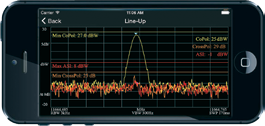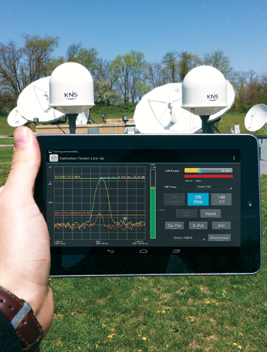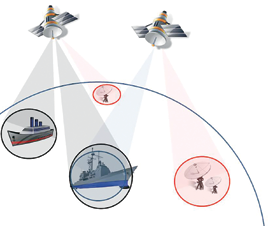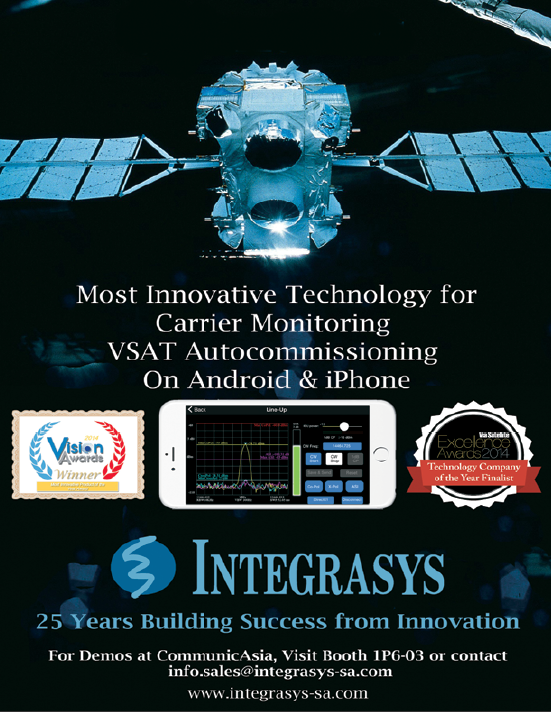Over the past several years, the maritime SATCOM industry has grown significantly, forced to do so because of ever-increasing global broadband coverage demands.

Satmotion running on an iPhone.
In order to fulfill customer needs, new satellites are being launch with much higher capabilities. High Throughput Satellites (HTS) deliver unlimited possibilities for increased satellite services by providers—this requires additional throughput and faster broadband connectivity.
Emerging HTS satellite operators are going to provide these new satellites with global coverage with broad beam coverage. This means an evolution is enroute for the VSAT industry, especially within the maritime segment to provide passengers and crews far better browsing, skipping and downloading experiences.
Passengers enjoying cruises are demanding high speed Internet connectivity for video and audio applications, which consume a great deal of broadband—much faster connectivity is, therefore, required. These new applications must coexist with the ship’s existing systems for such connectivity.

Integrasys Satmotion in use.
VSAT antennas are automatically pointed to the correct satellite, based on GPS positioning and accurate antenna tracking while the ship is moving. Prior to becoming operational, these antennas should be lined-up and commissioned by a certified SATCOM field engineer, who must travel long distances where a ship has been birthed, usually on a tight schedule, to arrange for a call with the NOC for that crucial operational approval. This process is quite time consuming and labor intensive.
Additionally, maritime antennas usually create cross pol interference as the ship moves about the world, especially if the antenna matrix is not correctly aligned with the satellite. Most of the time, the SATCOM installer must also travel to a given port to solve any issues—another expensive necessity. Due to maritime dishes being small, the transmissions from these dishes creates a wider beam width, which may affect the a satellite’s close-in angle from the target satellite, which creates ASI (Adjacent Satellite Interference).
Integrasys has developed a highly capable tool for enabling crew members to point peak and pol, while interferences are rapidly minimized. This means no additional SATCOM field experts are required, just the Satmotion Pocket product which guides the crew member regarding the line up for a proper alignment on the correct satellite and pol, without the need to arrange a call or have a certified installer present.
Line-up is measured at the hub with a Satmotion server, measuring Copol, CrossPol and ASI simultaneously and displaying the measurements at the ship in an intuitive way, aiding crew understanding of the alignment process. The crew should also have access to the antenna control unit for fine tuning. By controlling and guiding the crew, the line-up is managed and reported to the hub without the need of the previously mentioned third party personnel on the ship or the necessity of a hub or NOC operator call.

Satmotion maritime scenario.
This brings a significant cost savings—certified field engineer fees, travel expenses, ship delays, delayed or interrupted passenger experience, and interference penalties are avoided.
Nowadays, most of the stabilized maritime antennas use an open loop approach to align the linear polarization axis to that of the target satellite, continuously computing and adjusting the required angle, all according to current ship position and orientation. In order to maintain high alignment accuracy, this process requires low-drift and high-sensitivity inertial sensors and mechanical components, namely feed rotors and positioners.
Inadequate polarization alignment limits pointing tracking accuracy as well as signal acquisition range and speed, eventually resulting in loss of the tracking signal, which usually leads to a halt in VSAT transmission and the start of a rather long initialization procedure. In order to provide proper protection from open-loop polarization errors, preventing intra- and inter-system interferences, the transmitted power is proportionally backed-off, resulting in turns and a decrease of the usable bitrate.
Similar to fixed VSATs, the critical signal direction for polarization alignment in stabilized VSATS remains the uplink path. Achieving high accuracy levels by means of an open-loop adjustment approach requires high-quality electronic and mechanical components.
A second and equally important requirement is the need to perform an initial, accurate polarization alignment of the intended satellite. This is realized with a traditional clean-wave line-up procedure which effectively compensates all of the mechanical and electrical offsets in the end-to-end chain, providing an optimum starting point for the open loop algorithm with minimum error.

This line-up process must be performed for every target satellite that is to be accessed by any given VSAT and must periodically be repeated as a maintenance action to address VSAT component degradation or replacement, both of which reoccur in the harsh maritime scenario.
Line-up polarization adjustment is typically carried out by external qualified installers when the ship is docked in port when possible. However, some satellites may only be properly visible to the VSAT only in open seas. The lack of a high-quality uplink polarization initialization for any given satellite with regular cross-polarization requirements usually prevents the VSAT from using such satellites.
Currently, Integrasys is acquiring the technology upgrades that iDirect has applied to their product line for Velocity and Evolution with iDX 3.3 software release. This allows maritime service providers to experience “powerful capabilities in some of the most demanding environments” for providing customers with “better quality, more resilient service at higher performance.” Integrasys actively works with iDirect on iDX 3.3 to help customers achieve far more reliable communications when at sea.
Integrasys is the first company to be able to address and solve major challenges for global maritime networks worldwide with such innovative technology. Satmotion Pocket was awarded with the Most Innovative Technology Award at SATCON New York.
Currently, Satmotion Pocket supports multiple VSAT platforms from the major manufacturers, allowing most of the service provider to benefit from the use of this unique technology, which produces significant OPEX savings as well as maximizing the quality of service.

Integrasys will be demoing Satmotion Pocket at their CommunicAsia2015 booth 1P6-03 from June 2nd to June 5th at the Singapore Marina Bay Sands.
More info: www.integrasys-sa.com/
Alvaro Sanchez is the Sales & Marketing Director at Integrasys. He is responsible for Satellite Carrier Monitoring at Integrasys and for providing innovative solutions to satellite operators and service providers. Alvaro is the head of the USA office in DC area. Prior to joining Integrasys, he was a signal analysis expert at the CERN European Organization for Nuclear Research.


